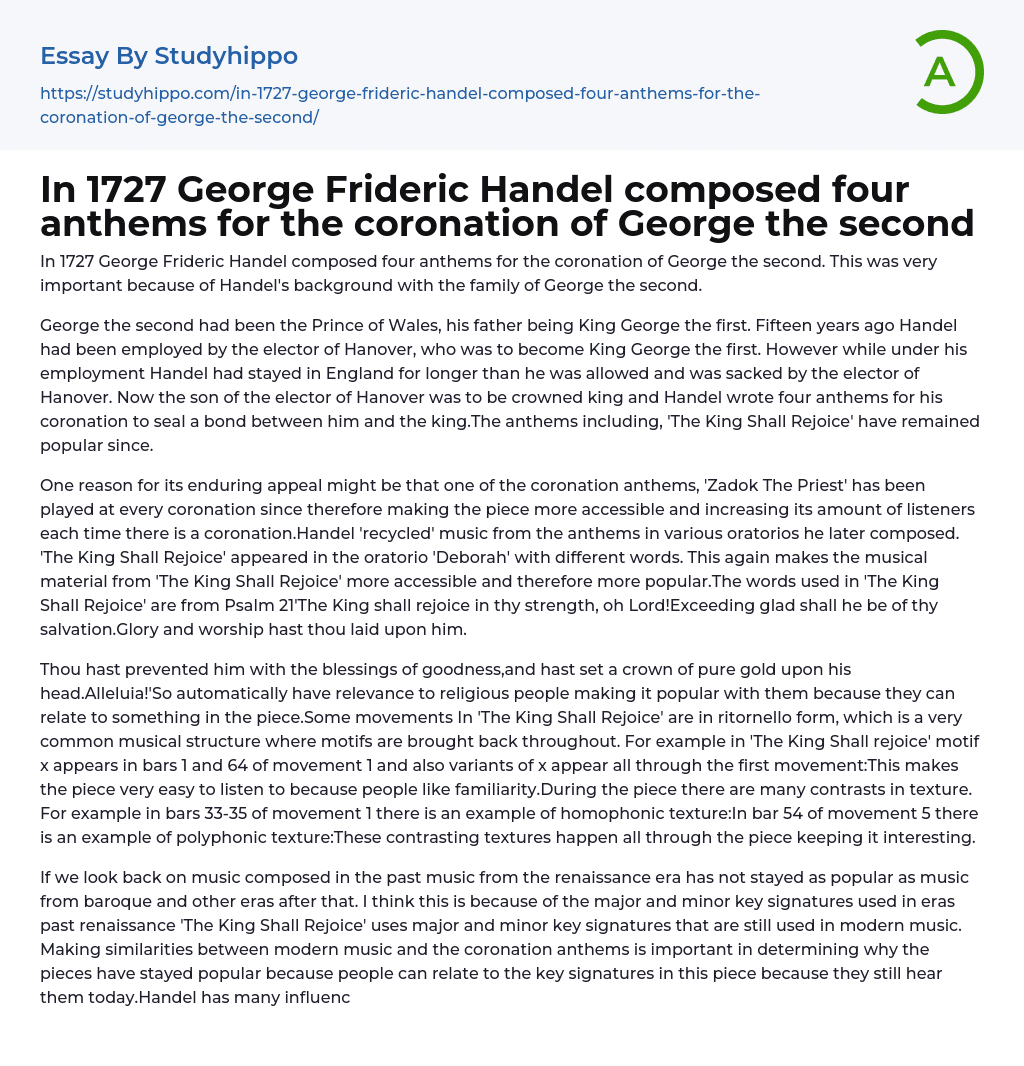In 1727 George Frideric Handel composed four anthems for the coronation of George the second. This was very important because of Handel's background with the family of George the second.
George the second had been the Prince of Wales, his father being King George the first. Fifteen years ago Handel had been employed by the elector of Hanover, who was to become King George the first. However while under his employment Handel had stayed in England for longer than he was allowed and was sacked by the elector of Hanover. Now the son of the elector of Hanover was to be crowned king and Handel wrote four anthems for his coronation to seal a bond between him and the king.The anthems including, 'The King Shall Rejoice' have remained popular since.
One reason for its enduring appeal might be that one of the coronation anthems, 'Zado
...k The Priest' has been played at every coronation since therefore making the piece more accessible and increasing its amount of listeners each time there is a coronation.Handel 'recycled' music from the anthems in various oratorios he later composed. 'The King Shall Rejoice' appeared in the oratorio 'Deborah' with different words. This again makes the musical material from 'The King Shall Rejoice' more accessible and therefore more popular.The words used in 'The King Shall Rejoice' are from Psalm 21'The King shall rejoice in thy strength, oh Lord!Exceeding glad shall he be of thy salvation.Glory and worship hast thou laid upon him.
Thou hast prevented him with the blessings of goodness,and hast set a crown of pure gold upon his head.Alleluia!'So automatically have relevance to religious people making it popular with them because they
can relate to something in the piece.Some movements In 'The King Shall Rejoice' are in ritornello form, which is a very common musical structure where motifs are brought back throughout. For example in 'The King Shall rejoice' motif x appears in bars 1 and 64 of movement 1 and also variants of x appear all through the first movement:This makes the piece very easy to listen to because people like familiarity.During the piece there are many contrasts in texture. For example in bars 33-35 of movement 1 there is an example of homophonic texture:In bar 54 of movement 5 there is an example of polyphonic texture:These contrasting textures happen all through the piece keeping it interesting.
If we look back on music composed in the past music from the renaissance era has not stayed as popular as music from baroque and other eras after that. I think this is because of the major and minor key signatures used in eras past renaissance 'The King Shall Rejoice' uses major and minor key signatures that are still used in modern music. Making similarities between modern music and the coronation anthems is important in determining why the pieces have stayed popular because people can relate to the key signatures in this piece because they still hear them today.Handel has many influences in this music. In 'The King Shall Rejoice' we can see examples of French influence in his use of hemiola:Handel also uses Italianate textures in the second movement when he has a three part instrumental texture:These different Influences in and English Anthem make 'The King Shall Rejoice' stand out from other baroque anthems and also make it pleasing
to other cultures.The 5th Movement of 'The King Shall Rejoice' is an Alleluia chorus, very common in anthems and also very popular, so although this is very clich� and obvious it is very effective in keeping the piece popular.
- Band essays
- Baroque Music essays
- Blues essays
- Classical Concert essays
- Classical Music essays
- Concert essays
- Hip Hop essays
- Jazz essays
- Ludwig Van Beethoven essays
- Michael Jackson essays
- Mp3 essays
- Music Concert Report essays
- Music Reference essays
- Music video essays
- Musical Instruments essays
- Opera essays
- Piano essays
- Popular music essays
- Recording essays
- Rock And Roll essays
- Rock Music essays
- Singing essays
- Sonata essays
- Song essays
- Sonnet essays
- Tupac shakur essays




